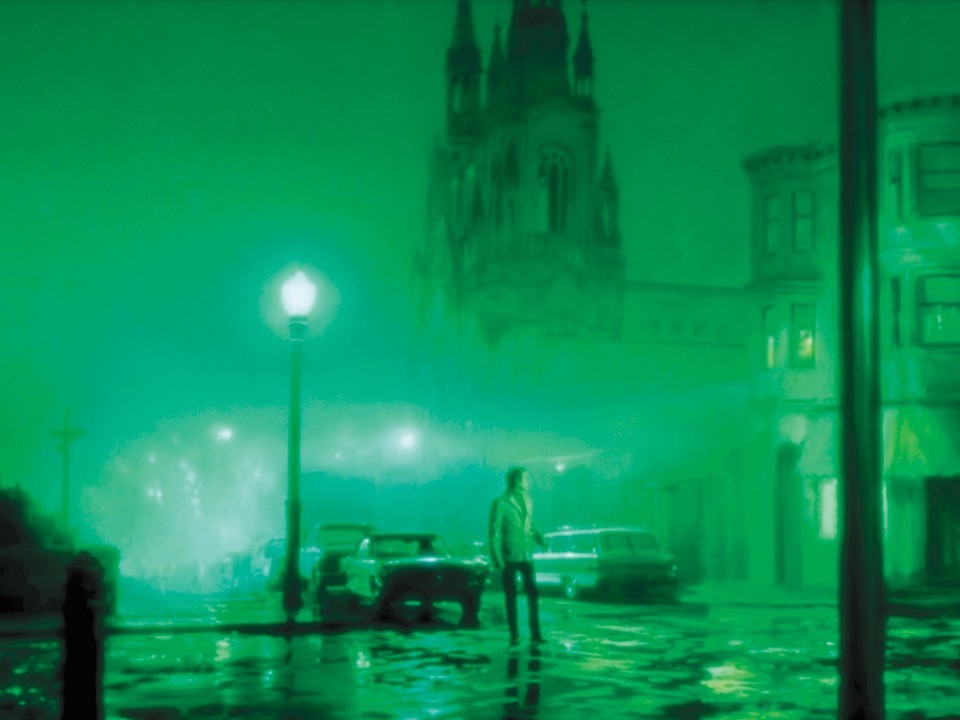The idea of visual artists recreating or altering elements from Hollywood's past is no longer an unusual one. In the last few years galleries have hosted installations of Psycho projected at a rate of two frames per second, the robbery scene in Dog Day Afternoon has been re-enacted by its real-life subject, and — in probably the most acclaimed and extensive of these postmodern appropriations — video artist Christian Marclay made a 24-hour fantasy solely from film images of clocks and watches, The Clock.
The Winnipeg-based filmmaker Guy Maddin has frequently experimented with the formal language of cinema, producing baroque, mannered variations on archaic silent film techniques and creating parodies of high-modernist styles that never really existed before. With The Green Fog, arguably the most ambitious experiment of his 35-year career, Maddin makes a claim on film language that is markedly different from the aforementioned gallery works. Foraging through miles of old movies and television shows, he dismantles the cinematic past as a way of reconstructing it.
Drawing entirely on recycled footage, Maddin and co-directors Evan and Galen Johnson have fashioned a remake — if you really stretch the definition — of Alfred Hitchcock's Vertigo, the much-admired story of murder, deception and neurotic, obsessive love. The 1958 film is the story of a San Francisco detective with a fear of heights. When a woman he's hired to follow leaps to her death from a church tower, he's consumed with guilt. He meets a woman with a slight resemblance to the deceased and projects his obsession onto her with tragic results. (You'd be well advised to catch a screening of the Hitchcock film at the Webster Film Series on Friday, May 3.)
You know the old game where someone whispers a message to a second person, who whispers it to a third, until the message itself has completely altered or disappeared altogether? The Green Fog uses a similar method to reconstruct Hitchcock's film, recreating it not through dialogue or specific actions but through purely visual associations. Drawing heavily on '70s crime shows, including The Streets of San Francisco and McMillan & Wife, Maddin creates connections to Vertigo by reusing a particular camera angle, a detail in the set decoration or even just the rhythm of an edited sequence. Nearly every aspect of the film — the watered-down colors and sledgehammer editing of TV drama and the sudden, unexpected appearances (and just as sudden disappearances) of Karl Malden, Claude Akins, Meg Ryan and dozens of other familiar faces — flaunts its discontinuity and challenges the viewer to find meaning in the clutter. Yet somehow the themes and spirit of Vertigo creep through, almost eerily.
It's fitting that this curious variation on Hitchcock's odd, disconcerting film is itself unsettling. In some ways it even transcends Vertigo to create its own crazy reality of halted moments and recurring calamities. Characters meet in restaurants, sit in offices poring over documents and drive aimlessly through the crooked streets. Maddin and company have removed most of the dialogue, so the characters rarely speak. They grunt, gasp and sigh, but they're helpless to communicate, frustratingly trapped in a narrative that remains unexpressed. We recognize the reassuring conventions of movies and television, but they're malfunctioning. The familiar back-and-forth connections of film editing have been knocked off track like a skipped record.
Despite the shifting heroes (one minute he's Michael Douglas, the next he's Chuck Norris or Andy Garcia) and unnerving silence, a protagonist gradually emerges: the city of San Francisco. Maddin reveals and celebrates the city's role as a cinematic fixture, its winding, vertiginous streets playing host to everything from cops and crooks (Bullitt and the Dirty Harry series) to alien invaders (the 1978 Invasion of the Body Snatchers). The Green Fog owes its fragmented narrative to Hitchcock, but it's also a testament to the consistent appeal of that eternally photogenic metropolis, as much a part of the romance and obsession of Vertigo as Kim Novak's haunting half-smile.


